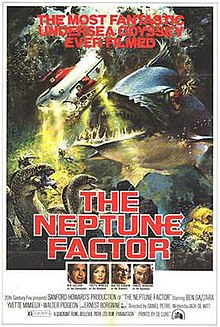The Neptune Factor
| The Neptune Factor | |
|---|---|
 | |
| Directed by | Daniel Petrie |
| Written by | Jack DeWitt |
| Produced by | Sandy Howard (as Sanford Howard) |
| Starring | Ben Gazzara Yvette Mimieux Walter Pidgeon Ernest Borgnine |
| Cinematography | Harry Makin |
| Edited by | Stan Cole |
| Music by | Harry McCauley Lalo Schifrin |
| Distributed by | 20th Century Fox |
Release date |
|
Running time | 98 minutes |
| Country | Canada |
| Language | English |
| Budget | $2.5 million[2] |
| Box office | $2,750,000 (US/ Canada)[3] |
The Neptune Factor, also known as The Neptune Disaster,[4] is a 1973 science fiction film directed by Daniel Petrie, featuring underwater cinematography by Paul Herbermann. The film's special effects utilized underwater photography of miniatures with actual marine life.
Plot[]
Marine scientists prepare to leave their underwater Oceanlab after an extended stay performing oceanographic research. An underwater earthquake interrupts their plans. Dr. Andrews (Walter Pidgeon) enlists experimental sub captain Adrien Blake (Ben Gazzara) to survey the damage and rescue the oceanauts. He brings along Chief Diver "Mack" MacKay (Ernest Borgnine) and Dr. Leah Jansen (Yvette Mimieux), fiancée of one of the scientists.
Blake finds the lab has been ripped from its moorings and has tumbled down an unexplored, deep ocean trench, presumably intact. With the lab's reserve air supply dwindling, the team descends into the unexplored trench and finds an incredible ecosystem populated with monstrously oversized fish.
After surviving encounters with unfriendly denizens, they find the lab partially intact, the surviving scientists breathing from scuba tanks and fending off giant, hungry eels. Diver Moulton sacrifices his life distracting the eels in order to enable the others to be rescued. The submarine returns to the surface with the two rescued scientists.
Cast[]
- Ben Gazzara – Commander Adrian Blake
- Yvette Mimieux – Dr. Leah Jansen
- Walter Pidgeon – Dr. Samuel Andrews
- Ernest Borgnine – Chief Diver Don MacKay
- Donnelly Rhodes – Diver Bob Cousins
- Chris Wiggins – Captain Williams
- Michael J. Reynolds – Dr. Hal Hamilton
- Leslie Carlson – Brigs, Triton Radioman
- Stuart Gillard – Diver Phil Bradley
- – Diver Stephens
Production notes[]
The film was based on an original story by writer Jack DeWitt. Gazzara and Borgnine's casting was announced in August 1972.[5] The movie has a subtitle of "An Underwater Odyssey".[6]
Filming began in Toronto in September 1972.[7]
The nature of the Oceanlab underwater facility bears a resemblance to real-world projects of the 1960s such as the ConShelf Two project of Jacques Cousteau, NASA's NEEMO, and the US Navy SEALAB.
Release[]
The film premiered in Florida in May 1973 and grossed $203,000 in its first four days.[1]
Reception[]
TV Guide gave the film one out of 5 stars, stating that while its underwater photography was well done, the film was predictable, the characters stereotypes and the story lacking.[8] The New York Times also praised the photography, but found little else of value in the film.[6]
See also[]
- List of American films of 1973
- Sealab 2020, a 1972 animated series about a futuristic underwater research base
References[]
- ^ a b "The Neptune Factor advertisement". Daily Variety. May 31, 1973. p. 5.
- ^ Solomon, Aubrey. Twentieth Century Fox: A Corporate and Financial History (The Scarecrow Filmmakers Series). Lanham, Maryland: Scarecrow Press, 1989. ISBN 978-0-8108-4244-1. p257
- ^ Solomon p 232. See also "Big Rental Films of 1973", Variety, 9 January 1974 p 19. Please note figure is rentals not total gross.
- ^ Alternate Titles for THE NEPTUNE FACTOR at IMDb
- ^ Murphy, M. (Aug 23, 1972). "MOVIE CALL SHEET". Los Angeles Times. ProQuest 157121416.
- ^ a b https://www.nytimes.com/1973/08/04/archives/screen-undersea-tale-neptune-factor-opens-at-neighborhoods.html
- ^ Murphy, M. (Aug 30, 1972). "MOVIE CALL SHEET". Los Angeles Times. ProQuest 157038077.
- ^ https://www.tvguide.com/movies/the-neptune-factor/review/107309/
External links[]
- The Neptune Factor at IMDb
- The Neptune Factor at the TCM Movie Database
- The Neptune Factor at Rotten Tomatoes
- The Neptune Factor at AllMovie
- Entire film on YouTube
- "The Neptune Factor (1973)". Model Ships in the Cinema (Blog). 2019-11-26. – Discussion of the special effects techniques used in the film.
- 1973 films
- English-language films
- 1970s disaster films
- 1970s science fiction films
- 20th Century Fox films
- Canadian films
- Canadian disaster films
- Canadian science fiction films
- Films scored by Lalo Schifrin
- Films directed by Daniel Petrie
- Films set in Nova Scotia
- Films shot in the Cayman Islands
- Science fiction submarine films